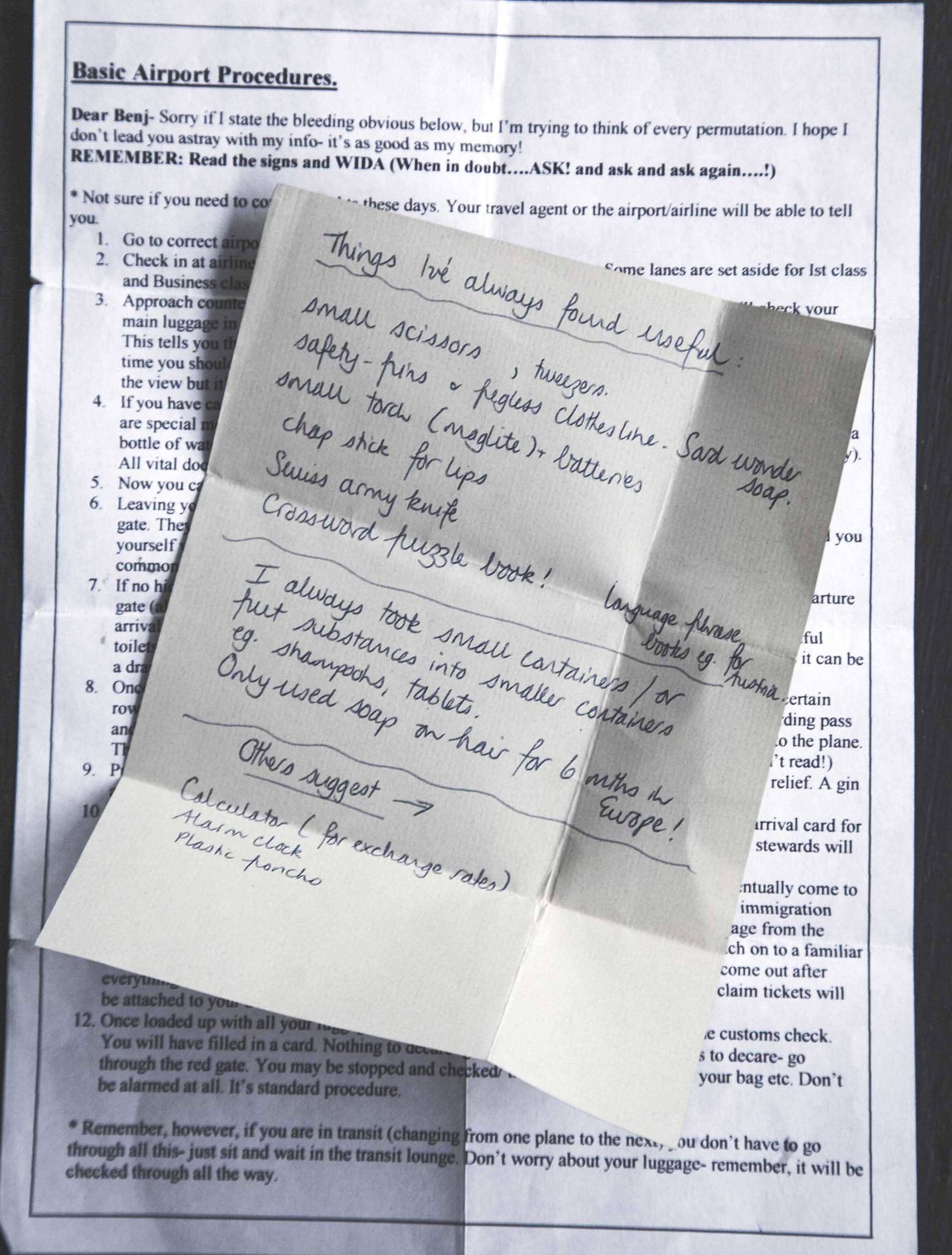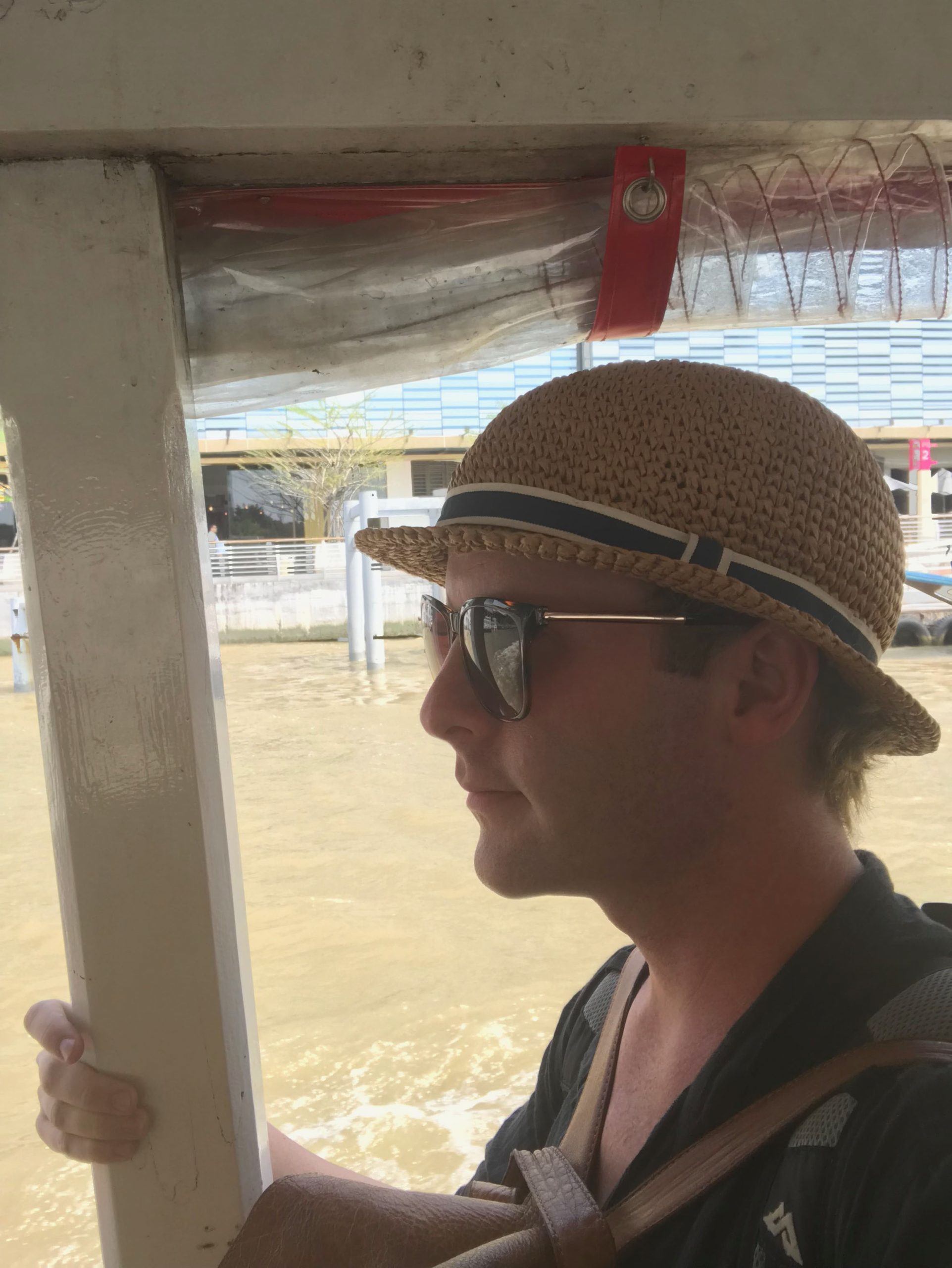I was recently sorting through old travel documents - from a bygone era - and came across a single-sided A4-typed letter from a close friend and travel guru, complete with the following sets of instructions: how to navigate immigration and customs and which items are essential to every backpacker. At the time, I was eighteen and had never left Australia. I was preparing to leave the security of everything I had known and embark on a life-altering journey. Her thoughtful, guiding words of wisdom led me down the path of travel success.


I had a great start and, as such, wish to offer you the same. Here is a comprehensive list of travel essentials I consider packing for every journey.
Clothing
- Several t-shirts. Include a variety of colours, to suit your needs and style, however don’t forget to incorporate diverse fabrics into your selection. This is invaluable when moving through different climates; it saves time when washing, and it can be a valuable protection from the environment i.e. mosquitos in hot climates are generally attracted to bright colours. Wearing loose fitting, plain coloured clothing will help serve as a mosquito deterrent.
- At least one dress shirt (for men), or dress (for women, unless otherwise inclined). An occasion may spontaneously arise in which you need to dress up. Many of my friends have been invited to weddings and other festive celebrations while on the open road. Something above casual to smart casual is always useful to have in such instances. It may save you a few valuable dollars better spent elsewhere. It also means you don’t miss out on experiencing something unique and special.
- One fleece, or warm jumper/cardigan. Merino wool is ideal for particularly cold climates.
- One wind proof jacket that is ideally water resistant as well.
- A cotton scarf. It’s a versatile accessory: worn around the neck, it’s fashionable and keeps you reasonably warm; worn around the forehead, it stops sweat pouring into eyes while trekking; worn around the waist, it can be used as a belt; placed under your head, it can also be used as a pillow in airport layovers and long bus journeys.
- One waterproof poncho. Rain occurs in all countries, regardless of what we like to think about island paradises. A poncho will save your clothes and health when you’re caught short in the middle of nowhere without shelter. It’s also smaller and less awkward to pack than an umbrella.
- Several pairs of shorts. Ensure they’re made from different fabrics to suit all your travel needs.
- A pair of long trousers for walking and hiking. Linen is cool and breathable, but something hardier is ideal to avoid rips and tears.
- At least one pair of dress trousers. See my comment above regarding dress shirts and dresses.
- A pair of jeans or comfortable trousers. They are versatile and, as mentioned already, comfortable – this is key when you’re having an ‘I miss home’ kind of day. Jeans can also be hardy, especially if you get caught short and need to hike without appropriate protective trousers. They can be dressed up or down, accessorised and used with multiple outfits, including a diverse array of shoe types. They’re a no-brainer.
- One pair of swimwear. Don’t forget the principles of modesty, respect and convenience when selecting an appropriate pair to pack. For women, this is particularly important, especially when traveling to conservative countries such as those in the Middle East. Board shorts for men, generally, are universally acceptable.
- A belt. It goes with most things, enhances outfits and keeps your trousers up after several bouts of Delhi belly and a significant weight reduction.
- Several pairs of underwear. I tend to be generous when packing underwear and consider quantity better than quality (in this instance). Some travellers wash a pair every day in the shower, but I tire of doing so after a few weeks.
- Several pairs of short and long socks. Ensure you have these in a variety of fabrics, to suit the various climates, temperatures and environments you may visit. Don’t forget that most countries around the globe have variable temperatures. If your feet are warm and dry, then so is your core.
- A hat or cap. Avoiding sunburn on long trips – or any trip, for that matter - is imperative. No-one wants to be peeling and barred from the sun while losing several layers of skin after a terrible burn. A hat or cap that can be folded is ideal, so it can be packed neatly into your checked luggage. Otherwise, you’ll be stuck carrying it through airports and onto transport. You also risk leaving it behind (which happened to me departing Cuba).
- An odorised bag for dirty clothing. Some backpacks, such as the one I recently purchased, come with one as a built-in inclusion. It’s useful in separating dirty from clean clothing every morning when getting dressed and can be whipped out at the laundromat immediately rather than having to sort everything at the last minute.
Save this article for future reference!
Shoes
- One pair of flips flops (British), sandals (American), or thongs (Australian). They are versatile and comfortable. They're useful in grotty public showers, trips to the beach and general travel through South America, South East Asia and Oceania. Their rubber versatility makes them an invaluable commodity on every pre-departure list. Sandals may be more fashionable, however they’re not nearly as ‘useful’ as a pair of thongs (I am Australian, after all). My personal preference is black Havaianas.
- One pair each of sneakers and tennis shoes. They provide comfort and protect against pedal wear and tear. They’re versatile and can be dressed up (tennis shoes, not sneakers) with decent trousers or dressed down for a day exploring a new city. I usually take a pair of black Adidas for day to day activities as well as a pair of slim sole white converse for dressing up.
- One pair of hiking shoes, or boots. These are not necessarily essential, unless you’re an avid hiker or trekker. They can, most of the time, be hired locally for major hikes such as in Arusha for Kilimanjaro or Kathmandu for Everest Base Camp.
Bedding
- A silk liner. When linen is unavailable or soiled and you suspect bugs may be present, a silk liner will protect you from the outside world (but perhaps not the bugs). It can be used instead of a sleeping bag in warmer climates and doesn’t weigh much.
- A yoga mat. If you find yourself without accommodation, a soft foam mat can serve as a faux-mattress. It beats sleeping on concrete and can be rolled and clipped to the side of a backpack with ease.
- A travel pillow. Not considered an essential travel item by most, I feel it is necessary. I’ve been caught short many times and have had to endure the discomfort of using a t-shirt, pair of trousers or jumper as a pillow. It’s hurt my neck and left me in pain for days. An inflatable pillow is light, doesn’t consume much space and can be used in many instances: under your head in planes, trains, buses and cars as well as in public spaces. It can also be used as a cushion for uncomfortable seats.
Toiletries and Hygiene
- Clothes line. You may like to think that you don’t smell or that you’ll just drop your clothes into a dry cleaner once a week when traveling. The reality: we all smell after a while as do our clothes, and you’ll have neither the time, money nor desire to send them to be cleaned every week. Washing your underwear and socks in a basin or shower and hanging them for the day isn’t as burdensome a task as you think, and it will save you a fortune in the long run – money better spent on a rickshaw, train fare, alcoholic beverage or nice meal.
- Sachets of washing powder. Rather than use your body wash, shampoo or cake of soap, take a few sachets of washing powder. Simply drop them into the basin with your clothes, squeeze and swish, then rinse with water.
- A toiletry bag. It makes bathroom time a no-fuss-affair, especially when the bathroom is communal. Ensure the bag includes a small mirror, beneficial for both men and women. Items to include are:
- A toothbrush;
- Toothpaste;
- A hairbrush or comb;
- A cake of soap;
- Razors;
- Nail clippers (for extended trips);
- Tweezers (yes men, bushy eyebrows need attention – it’s called man-scaping); and
- Small bottles of shampoo and conditioner, unless you wish to use soap to wash your hair.
- Hand sanitiser. Many public bathrooms do not supply soap. As a nurse, I can confidently say that hands are the place of the external body on which most microorganisms reside. They’re filthy and can become highly infectious to you and others. As such, carrying a small bottle of hand sanitiser in a day bag is essential, especially when you’re visiting restaurants of countries in which it is customary to eat with your hands.
- A roll of multi-ply toilet paper or wet wipes. There will be times in which nature calls, and toilet paper may not be available. Rather than tearing the thin rough pages from your favourite paperback, carry a roll of your favourite soft toilet paper or a packet of wet wipes in a day bag. It may save you a little discomfort and a lot of embarrassment. Trust me!
- A microfiber towel. Not all hostels and lodgings supply towels. They do hire them; it ends up being very expensive after months of continuous travel. Microfiber towels are priceless: they clean you satisfactorily, dry very quickly, pack lightly and cost you nothing to use, after the initial purchase. I’ve always used them and although I prefer using a full-size fluffy towel made of Egyptian cotton, it wouldn’t be practical to carry while traveling.
Health
- A First Aid Kit. Even if you have never completed a first aid course, having the supplies on hand will appease foreboding subconscious anxiety, particularly when traveling alone in isolated rural areas. Knowing the basics regarding the utilisation of products within your kit will be advantageous. A good kit should include:
- Band-Aids (plasters) in various sizes;
- Triangular bandages;
- Rolled bandages;
- Safety pins;
- Sterile gloves (disposable);
- Tweezers;
- Scissors;
- Cleaning wipes (alcohol free);
- Brown or white tape;
- Sterile gauze dressings in all sizes;
- A sterile eye dressing;
- Thermometer;
- Antiseptic cream;
- Insect repellent;
- Aloe Vera;
- Hydrocortisone cream;
- Distilled water for wound cleansing;
- Eye wash;
- Antihistamine tablets;
- Analgesia, such as paracetamol, ibuprofen and aspirin;
- Disposable thermal blanket; and
- Blister pads.
Financial
- Debit and credit cards. Visa is the most universally accepted type of card, followed by MasterCard then American Express (Amex).
- Cash. It’s important to diversify your payment options, especially in cash economies such as Cuba. Plus, there may be times when your card simply doesn’t work. It can be stressful and embarrassing to have ordered a meal and eaten it without being able to pay. Carrying some cash, in either USD or Euro, is essential and highly practical.
Documentation
- Passport/s. This item is self-explanatory. I always carry this in my hand luggage, in a secure inner console close to my body. It’s also where you’ll find my bank cards and other important documents. Many carry it in a pouch wrapped around their waist or hanging from their neck underneath clothing. If security is a concern in the country you’re visiting, then utilise this option. If your bag is stolen, at least your passport – your LIFE while abroad – will be safe. I now have a pair of underwear that contains pockets for passports and bank cards. They’ve been invaluable in Central America.
- Driver licence. This is beneficial, particularly if you’re considering hiring a car or motorbike/scooter. If you are certain you’ll hire a car, then obtaining an international driver licence pre-departure is advisable: it’ll make the hiring process much less arduous. In some countries, an international licence is a necessity, so ensure you research this prior to departure.
- National Identity Card. This is useful only for those traveling to sister nations, such as European citizens traveling within the European Union (EU). Mostly, a passport will be required for international travel.
- Travel and/or medical insurance. This is OBLIGATORY. Any traveller who leaves home without it is, frankly speaking, STUPID. Unless you’re superhuman, you cannot predict the future. As such, we know neither the time nor the place in which the bus we’re on may crash, the chicken we eat might give us food poisoning worthy of a hospital stay, or the scooter we’re riding will be hit by a car and we’ll need emergency air evacuation to the nearest hospital. Things get stolen, we get sick and other unfortunate circumstances arise in which we need protection. DO NOT TRAVEL WITHOUT IT.
- Photocopies of important documentation i.e. passport/s, bank cards, travel insurance and other identification cards. These should be kept in an alternative piece of luggage to the originals, in the instance only one bag is stolen or lost. Additionally, I would highly recommend maintaining up to date and easily accessible electronic copies of these documents: they’re more difficult to steal and relatively easy to print if needed!
Navigation
- Your choice of travel guide. Although you may wish to create your own journey replete with spontaneity and individuality, these ‘travel bibles’ are useful when getting lost, physically and existentially. They are a reliable backup if your intrepid sense of adventure and spontaneity fail and leave you stranded. I don’t recommend living by a guide as though a Christian would the Bible, however they can be practical when you’re feeling tired, weary, uninspired or unadventurous. They shouldn’t detract from your overall experience and I wouldn't follow their every word – unless you wish to end up as part of the pack. There are many varieties on the market, so do your research and choose one that suits your style and preferences.
- A map. If your travel guide does not include a map of either the region, country or city you are intending to visit, then buying one will be highly advantageous. Even without a car, knowing the major roads and routes will help you identify the direction in which you need to walk or travel.
- An electronic device i.e. IPad, smart phone or IPhone. Even though I lived for many years travelling without one, I now find it hard to live sans technology when navigating foreign cities. The application maps.me is invaluable and has revolutionised my navigational capacity.
Record-Keeping
- At least one camera. This is entirely a decision of personal preference. Some people like simple digital cameras and others prefer SLR varieties. Whichever it is that makes you happy, pack it. Capturing exceptional travel moments is invaluable: our memories eventually fade, and we may never return to the places with which we’ve fallen in love. Although some overdo it and snap every moment of every day, it’s important to digitally capture at least some moments in time.
- A travel journal. Regardless of whether you write explicit details of your innermost thoughts and feelings, or simply record objective statements regarding the day’s events, making a record is important. As mentioned above, memories fade; reading about the experiences years after the event helps you sharpen the recollection and relive the moment through tears, laughter, smiles, frowns and a myriad of other emotions. Some now opt for digital journals in the form of blogs; ensure your audience is receptive to that which you plan on writing, and that your writing is grammatically correct and stimulating. Few people, aside from perhaps your parents, want to read about the mundane. However, creating something authentic, audacious and read-worthy doesn’t require expert writing skills: use your imagination, keep it simple and recount one idea per entry. Remember, you’re the one traveling, not your readers. They want to live vicariously through your experiences. Practice does make perfect.
Communication
- Unlocked mobile phone of your preference i.e. iPhone or smart phone. It speaks for itself.
Eating
- Metal knife, fork and spoon. If you spontaneously decide to trek the Jesus Trail from Nazareth to the Sea of Galilee, then aside from the tent and sleeping bag, you’ll also need eating instruments. Additionally, in times of financial difficulty, as outlined below, resorting to tinned food is likely: having a fork with which to eat the beans that you’ve bought from the local supermarket may prove useful.
- Can opener. In times of financial distress, baked beans or tinned tuna may become your mealtime options. As such, having a can opener or, alternatively, a Swiss army knife on hand can be beneficial. Alternatively, you could opt for having only a Swiss army knife (outlined below).
- Swiss army knife. Its uses are multitudinous: cutting food, employing personal safety strategies in dangerous circumstances (I’ve never done this), getting into tinned food without a can opener, opening corked wine bottles, carrying the keys to your hostel dorm room, removing debris from your teeth and plucking overgrown hair from your travel weary eyebrows are a few. It’s a highly valuable resource to pack.
Electronics
- International adapter. Ensuring you can charge your camera and phone and use the hairdryer you now regret packing is important, but only possible with an adapter for the charger. Unfortunately, plugs are not universal and require the use of an adapter through which the charger can be plugged in to the outlet. If you’re traveling to multiple continents, a universal adapter will be necessary, as plugs are variable between continents. Mine has never let me down.
- Cords for phones, laptops, kindles, iPads/tablets and other electronic devices. This is self-explanatory.
Other
- Several snap lock bags.
- Head torch.
Not essential but potentially useful (open to debate)
- A single person tent. I’m not a camper personally, however, having a small lightweight tent in your possession can be particularly beneficial in these cases: some hostels offer cheap rates for those travellers who wish to pitch their tent in the garden or outdoor space; if you get dumped in the middle of nowhere without accommodation options, having a tent certainly beats sleeping unprotected on a bench or on the grass. Obviously, with a tent, you need:
- A sleeping bag. Again, it should be lightweight, breathable and compact; you don’t want it to occupy too much space, and it shouldn’t break your back to carry. One to suit all warm climates is ideal, unless - of course - you’re planning a trip to a ‘brass monkey’ destination, such as the Himalayas.
Personal preference but not essential (again, open to debate)
- Pyjamas. If you sleep naked, then this will not be an item you’ll consider, unless of course you intend to sleep in shared lodgings. I simply use a t-shirt and soft cotton shorts or trousers. However, if you’re a pyjama fanatic, then I recommend packing something that makes you comfortable. Sleep, after all, is valuable.
- A laptop. Having a large screen and full keyboard is more convenient to use when booking tickets, doing research and watching films on long bus trips. They can be a liability, however, and tend to weigh on the heavier side. Think twice before packing yours.
- A kindle/tablet. As a traditionalist and a book lover, I personally prefer reading books with tangible pages; carrying them around the world, however, is not always practical. Downloading your favourite reads onto a kindle or similar device befits the cliché of taking long train, bus and plane journeys: you can lose yourself, kill time and laugh out loud so those around you become suspicious.


